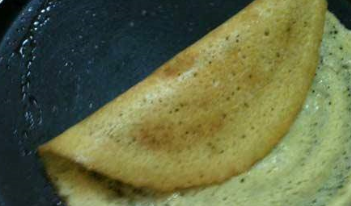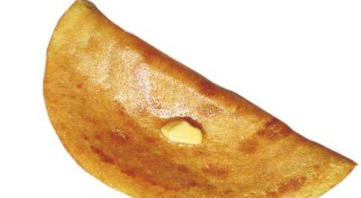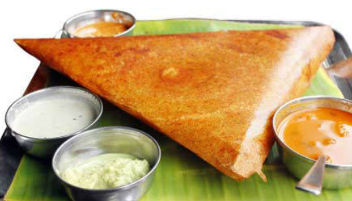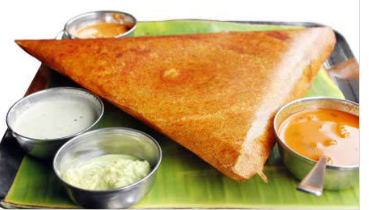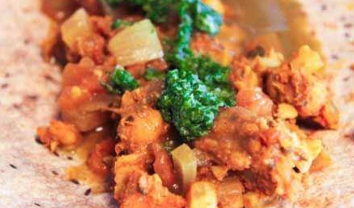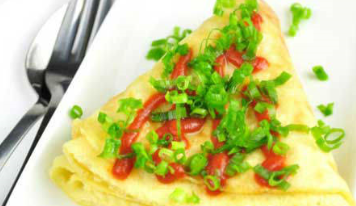Dosa: Tamil-Udupi Cuisine
This is a collection of articles archived for the excellence of their content. Readers will be able to edit existing articles and post new articles directly |
Contents[hide] |
Dosa: History
A
Meenakshi Devaraj, May 13, 2024: The Times of India
One of the earliest Tamil references to the word ‘dosa’ can be found in the eighth century dictionary, the Nigandus. The Nigandu ‘Chentham Diwakaram’ categorises dosa under the pancake-like ‘appam’ variety, while the 10th-century ‘Pingala Nigandu’ makes a mention of ‘kanjam’ as another name for dosa. Apart from the Nigandus, the 18thcentury ‘Virali vidu thoothu’ is an early Tamil work that mentions dosa.
Clearly, the dish, a staple, in most homes in Tamil Nadu, has a history that steers back to kitchens hundreds of years ago. When a recent talk show on a private Tamil channel delved into the emotional connection Tamil Nadu has with this crispy delight that graces breakfast tables along with its fluffier more illustrious cousin, the idli, it brought up questions on the origins of the culinary staple. Clues to this lie not just within the annals of Tamil literature but in the halls of temples across the state.
In Vishnu temples, food offerings to deities are referred to as ‘amudhu’ and here, dosa appears to take pride of place. There are numerous inscriptions dating to the 16th century that make references to the word ‘dosa’.
Inscriptions at Vishnu temples in Tirupathi, Srirangam, and Kanchipuram mention that the service of donating money for the dosa offering was prevalent at the time and called ‘dosapadi’. One of them, at the Kancheepuram Varadaraja Pe- rumal temple (1524AD) details a donation given for dosa by the famous Vijayanagar King Krishnadevarayar.
It says that he had donated 3,000 panam for the dosapadi service. Land was purchased with this amount and 15 dosa offerings were made to the deity every day. In the same temple, an inscription dating to the reign of Vijayanagar king Achutaraya mentions a dosa offering made during the celebrations of the birth of lord Krishna. It’s unusual as dosa is not identified as among the sacred dishes made for Krishna Jayanthi celebrations today.
Seventeenth-century inscriptions at the Parthasarathy temple in Chennai also mention dosa offerings for important temple festivals as do Ramanathapuram copper plates be- longing to the same era. This would mean that by the 16th century, the dosa offering had become common in famous Perumal temples of the Tamilspeaking region. Even today, the dosa offering is special in famous Vishnu temples such as Azhagar Kovil, Singaperumal Kovil and Varadharaja Perumal Kovil. Most temple inscriptions mention the ingredient measurements given to make the dosa offering.
For example, a Tamil inscription in Tirupathi details the measurements for the offering as three marakkal (around three kilos) of rice, one marakkal and three nazhi (nearly one and a half kilos) of black gram, one nalli and one uri (around two litres) of ghee. Some inscriptions even give recipes for different dosas. A Tirupathi temple mentions that sprinkled on top of the dosa offering. Everyone knows that dosa is prepared with rice and urad dal batter, but few inscripKanchipuram mention a spicy dosa with cumin and pepper added to the batter.
Tamil cookbooks of the 19th century such as ‘Nalaveemma bagasasthiram’ also mention the same spicy dosa with cumin and pepper. The cookbook in fact has recipes for every kind of dosa from the spicy one with red chili, fried urad dal and asafoetida to sweet dosa with sugar. ‘Hindu bagasasthiram’, another old cookbook, lists recipes for a variety of dosas such as thengai dosa (coconut), vendhaya dosa (fenugreek), vengaya (onion), vella (white), kodumai maavu dosa (wheat flour), paal dosa (milk), pirandai dosa (made with a traditional herb) and paayatham paruppu dosa.
The 2,000-year-old Sangam work ‘Madurai kaanji’ describes a food named ‘adai’ (similar to dosa but a different batter) sold on the streets of Madurai. Fast forward to present day, and the dosa culture shows no signs of waning. A recent report from food delivery service platform Swiggy says 29 million dosas were served up in the past year alone.
In March, MTR Foods created a Guinness World Record for the lengthiest dosa at 123ft, the effort of 75 chefs and overcoming 110 previous unsuccessful attempts. It’s nothing new when you think about it as an inscription in Tirupathi, dating to the 16th-century, mentions the ‘pattanam dosa’, a big dosa, which was made in those days. So, the next time you make or order a crispy dosa, large or small, or even read about a batter record, remember, you’re savouring centuries of Tamil culinary legacy. (The writer is a researcher of Tamil culture)
Recipe: Ada Dosa
Many homemakers have their signature way of making the ada dosa as they think about various permutations of proportions of the basic ingredients. The end result leads to a crispy and crunchy dosa which children like a lot.
Ingredients
Chana Dal: 100gms Tuvar/arhar dal: 100 gms Urad dal: 100 gms Rice: 50 gms Salt to taste
Method
Soak all the ingredients chana dal, tuvar dal, urad dal and rice for about 3 to 4 hours. Make a fine paste of the soaked dalrice mixture in a grinder. The results will be good if the water in which you have soaked the dal and rice is used for grinding the mixture. Add some 50 to 100 ml extra water while making the paste if you think the batter will become too thick. After achieving the desired consistency, add salt to taste. Keep the batter aside to settle for about 15 minutes. Once you are all set with chutneys and sambar, you can start making the ada. First heat a non stick flat tawa. Sprinkle some oil on it and spread the oil evenly. Then use a flat bottomed small katori and spread the batter onto the tawa evenly. Start spreading the batter from the centre and go on till it spreads out. Add a little oil to all the corners (in this case since it is a circle you would have to add the oil across the perimeter!). Once you spot the dosa turning golden yellow in colour you can take it out of the tawa and serve along with coconut chutney or sambar either way you like.
Healthy breakfast: Healthy beetroot dosa recipe
Healthy Beetroot Dosa
Ingredients
Beetroot 1 (grated) Maida 1 ½ cup Onion 1 (finely chopped) Green chillies 2 (finely chopped) Baking powder ½ tsp Curry leaves 1 spring (finely chopeed) Water, oil and salt as required
Method
Take a bowl and mix in grated beetroot, onion, green chillied, baking powder, curry leaves, salt and maida with water. Make sure your batter is lump free. Heat a frying pan and pour some batter. Give the batter the shape of a dosa. Put a few drops of oil on top. Fry on medium flame till the dosa is completely cooked and golden brown on both sides. Keep repeating the same procedure, till the batter finished. Serve hot, with mint chutney.
Healthy dosa: Fibre rich bean dosa
Ingredients
1 Cup pinto beans 1 Cup black eye beans 2 Thai green chillies 1/4th piece of ginger 2 Tsp salt
Method
1. Soak the beans overnight. 2. Blend all the ingredients together. 3. Heat pan, spread the batter, steam it by covering with lid or drizzle oil. 4. Enjoy the delectable soft, healthy dosas with kale/tomato chutney.
Healthy snack: Moong beans sprouts dosa recipe
Ingredients
1 cup sprouted green moong 2 cloves garlic 1 small piece of ginger 5 tablespoons semolina 5 tablespoon gram flour 34 green chillies Salt to taste 1/8 cup oil
Method
1. In a mixer grind sprouts, ginger, garlic and green chillies coarsely. Use water only to reach dosa/pancake batter consistency. 2. Mix in salt, semolina and gram flour. 3. Heat a pan/tava on highmedium heat and spread one ladlefull of batter into a dosa. 4. Drizzle some oil and let it cook on one side. Flip over the other side and drizzle some oil again. Cook both the sides well. 5. Remove from pan and serve with chutney of your choice.
Notes
Use stuffing such as paneer, onions or potatoes to fill the dosas. Do not grind into a fine paste. The coarse texture is better and tastier.
Healthy version of the dosa with mint chutney
Ingredients
5 cloves garlic, minced 1 red onion, peeled and finely diced 1 carrot, peeled and finely diced 1 red pepper, finely diced ) 1/4 tsp cayenne pepper 2 Tbsp cumin, ground 1 Tbsp oregano 12 tsp salt 1 Tbsp turmeric 4 cups cooked or canned chick peas (about 2, 160z cans) ½ cup (4oz) tomato paste
Directions
1.Heat a large saucepan over medium to low heat. Add the garlic, veggies, and spices, cooking until soft, stirring occasionally. 2.Mash the chickpeas by hand, or in a food processor. Add the chickpeas and tomato paste to the saucepan, stirring until heated through. I left mine a little chunky so you could still see some whole chickpeas in the filling.
3) =Coconut curry sauce=
Ingredients
1 onion, peeled and chopped (I used a red onion) 2 cloves garlic, minced ½ tsp cumin, ground ¾ tsp sea salt (coarse) 3 Tbsp curry powder 1.5 cups vegetable broth 1.25 cups coconut milk 3 large tomatoes, diced
Directions
1.Heat a saucepan over medium heat, add the onion and garlic, cooking for 5 minutes, or until soft. Add the spices, cooking for 1 minute more. Add the vegetable broth, coconut milk and tomatoes, stirring occasionally. Let it simmer for half an hour.
4) =Fresh mint chutney=
Ingredients
2 cups packed fresh mint 1/4 cup water 1 shallot, peeledJuice from 1 lime 1 Tbsp organic sugar 1 pinch sea salt
Directions
1.Blend all ingredients in a food processor until you have a course puree. Taste and adjust seasonings, if necessary.
To assemble
Take one of your "dosas" and top it with the curried chickpea mixture. Add the coconut curry sauce and top with 12 tbsp of mint chutney.
Healthy snack recipe: Green Dosa
Recipe: Green Dosa Serving size: 4
Ingredients
Green moong dal, soaked 1 cup Rawa ¼ cup Soy flour ¼ cup Flax seed powder 2 tsp Salt to taste Green chilli (Finely chopped) Oil 5 ml
Method
Grind the soaked green moong dal, soy flour and rawa to form a batter (of dosa consistency). Later add salt, flax seed powder, green chilli to the batter. Make dosas out of that batter on a nonstick pan. Serve hot with tomato chutney.
Nutritional value
2 masala dosas provide the daily calories needed
Sunitha Rao, December 23, 2018: The Times of India
The all-time favourite masala dosa may be deceiving you with its thin, golden look and humble potato filling. The aroma of melting butter and red chilli chutney would make you crave for one, but what probably only a few would know is that a single masala dosa provides almost half the calories a healthy human being requires in a day.
A four-continent, fivenation study has quantified the calorific content of masala dosas sold in Bengalauru at 1,023 kcal, while the daily requirement of a human being stands at around 2,200 kcal. The findings were recently published in the British Medical Journal.
Led by Prof Rebecca Kuriyan, head of Nutrition and Lifestyle Clinic at St John’s Medical College Hospital and Professor at St John’s Research Institute, the study-,conducted in 2017, measured the calorific content of frequently ordered meals from sit-down and fast-food restaurants from India, Brazil, China, Finland and Ghana.
As per Prof Rebecca, the recommended calorific content of a single meal should be less than 600 kcal.
“This study showed over 94% of meals served at full service restaurants and 74% at fast-food restaurants contained over 600 kcal each,” said Prof Rebecca. The research findings have been shared with FSSAI, urging the government to mandate restaurants mention calorific value of the food items sold.
